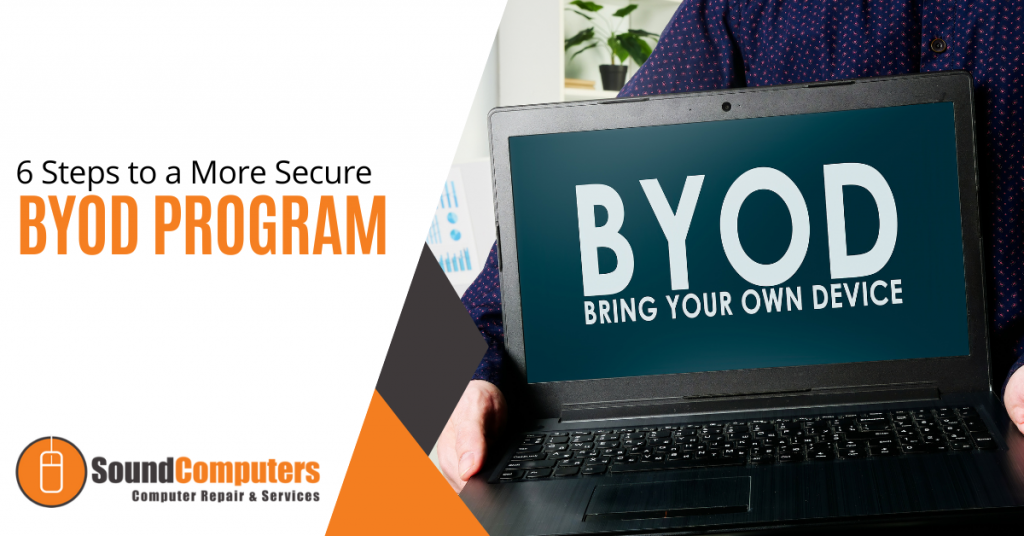
More employees are working remotely which means that the bring your own device (BYOD) trend has grown in popularity.
58.3% of surveyed employees said their use of personal devices for work increased during the COVID-19 pandemic.
BYOD programs can offer a number of benefits for businesses including increased productivity and flexibility. However, there are also security risks that come with BYOD programs.
In order to reduce these risks, businesses should take the following steps:
Define The Scope of The BYOD Program.
The first step in creating a secure BYOD program is to define the scope of the program.
- What devices will be allowed?
- What apps and data will employees be able to access?
By defining the scope of the program, businesses can set clear expectations for employees and reduce the risk of unauthorized access to company data.
Be sure to differentiate between devices that are for work and devices that are for personal use. Devices that are for work should be dedicated to work tasks and should not be used for personal tasks.
There should be a clear definition of what devices are allowed on the network in order to maintain BYOD programs. This will ensure that only approved devices are used and that will minimize security risks.
Develop Policies and Procedures for Employees.
Once the scope of the BYOD program has been determined, businesses should develop policies and procedures for employees.
These policies should cover topics such as:
- Device Security
- Data Security
- Acceptable Use
By having clear policies in place, businesses can ensure that employees are aware of their responsibilities and the risks involved with BYOD.
Employees should be made aware of any changes to the policies and they should also be given the opportunity to ask questions and provide feedback.
Educate Employees on Security Risks.
One of the most important steps in creating a secure BYOD program is educating employees on the security risks involved. Employees should be made aware of the risks of downloading malicious apps, accessing unsecured Wi-Fi networks and sharing company data.
By educating employees on the risks, businesses can help reduce the likelihood of a security breach.
When it comes to security, ignorance is not bliss.
Businesses should also provide employees with the necessary tools to help them secure their devices. This can include mobile device management (MDM) software, data encryption and antivirus protection. Employees should be trained on how to use these tools and how to keep their devices secure.
Implement Security Measures.
In order to further reduce the risk of a security breach, businesses should implement security measures such as:
- Mobile device management (MDM)
- MDM can help businesses control which apps are installed on employee devices and remotely wipe data if a device is lost or stolen.
- Data encryption
- Data encryption can help protect company data if a device is lost or stolen.
- Antivirus protection
- Antivirus protection can help protect devices from malware and other malicious software.
- Firewalls
- Firewalls can help protect devices from malicious traffic.
These are just a few of the many security measures businesses can take to reduce the risk of a security breach.
By implementing these measures, businesses can help keep their data and devices safe from harm.
Monitor the BYOD Program.
Businesses should monitor their BYOD program on an ongoing basis. They should keep track of which devices and apps are being used as well as any security breaches that occur. By monitoring the BYOD program, businesses can quickly identify and address any security risks.
Businesses can also ensure that employees are complying with BYOD policies. For example, you can track which devices are accessing corporate data and ensure that only authorized devices are being used.
By keeping track of which devices and apps are being used, businesses can quickly identify and address any security risks.
60 percent of endpoints are mobile devices and are woefully under-protected.
Review and Update the BYOD Program Regularly.
The BYOD program should be reviewed and updated on a regular basis. As new devices and apps become available, the program should be updated to reflect these changes. Businesses should also review the program if there are any changes in the company’s security posture.
Reviewing and updating the BYOD program is essential for businesses to keep their data secure. By keeping the program up-to-date, businesses can ensure that only authorized devices are being used to access corporate data.
Be Proactive with Help from Sound Computers.
These are just a few of the many steps businesses can take to create a secure BYOD program. By being proactive and taking the necessary steps, businesses can help reduce the risk of a security breach.
Breaches cost businesses time, money and resources. It is important to do everything you can to prevent them.
Do you have a BYOD program in place? What steps have you taken to ensure the security of your data?
No matter what size company you have, security is important. Contact us at (860) 577-8060 or via our contact form to learn more about our security solutions.